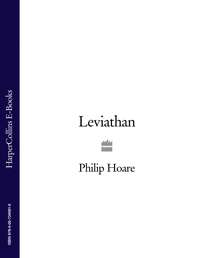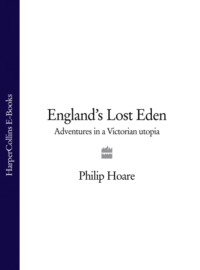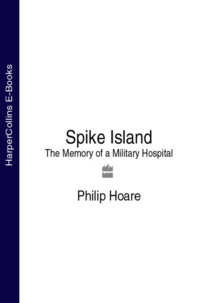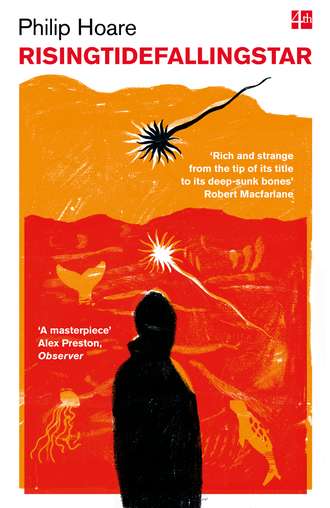
Полная версия
RISINGTIDEFALLINGSTAR
Pat is in her eighties now. She doesn’t paint much any more. She doesn’t have to. When she talks to me in the morning, the sun already turning the deck hot by eight o’clock, she carelessly raises her leg above her head in a yoga pose. She weighs one hundred pounds. She is wired as much as muscled. She still sunbathes naked in the dunes, where national park rangers have threatened to issue her with a ticket for flouting the bylaws. Pat tells them they can do what they like; she’s been doing this for seventy years, and she’s not about to stop now. She walks barefoot all day – ‘Bare feet are older than shoes,’ as Thoreau says – padding along the beach, more animal than human. All the time I’ve known her, she has always kept German Shepherds close to her. They are wolves in disguise, just as she is half dog herself. It’s taken me fifteen years to hear her story; she keeps it in reserve, hidden in her cupboards and drawers. The withholding only makes the past more present.
Pat was born in London in 1930, but in 1940, when she was ten years old, she and her brother were sent to America by their parents. She still finds this extraordinary, as if she can’t quite believe it even now. Her father, Ernald Wilbraham Arthur Richardson, was born into the landed gentry in 1900; his own father, who had served in the South African war, was English-Welsh, and his mother was Irish; the family had a large country estate in Carmarthenshire. Ernald followed the progress of his class, from public school to Oxford, but his passion was skiing, and he was an Alpine skiing pioneer in the nineteen-twenties, photographed on the slopes as part of the British ski team, a dashing young man. In 1929 he had travelled to the US, where he met and married Evelyn Straus Weil, a smart, chic young New Yorker of twenty-three with dark hair and big bright eyes whom her daughter would describe as a flapper. She had a decidedly more cosmopolitan background than her English husband.
Evelyn’s grandfather was Isidor Straus, a German-born Jew who had joined his father, Lazarus, in New York in 1854. There the family forged a remarkable partnership. Lazarus Straus went into business with a Quaker from a celebrated Nantucket whaling family, Rowland Hussey Macy. Their department store boomed. In 1895, Isidor and his brother Nathan took over ownership of the store. They had now become a firm part of American life. Both were philanthropists; Isidor had raised thousands of dollars to aid Jews threatened by pogroms in Russia, and Nathan’s son, also called Nathan, would try to get visas for Anne Frank’s family. Isidor, Pat’s great-grandfather, became a member of Congress and turned down the office of Postmaster General when offered it by President Grover Cleveland. Isidor was devoted to his wife, Ida, and their seven children, among them Minnie, Pat’s grandmother.
On 10 April 1912, after a winter spent in Europe, Isidor and Ida boarded a new luxury liner at Southampton, bound for New York. Five days later, in the early hours of 15 April, as Titanic struck an iceberg and began to sink 375 miles south of Newfoundland, the couple’s devotion to each other became a modern legend. Ida declined to get into a lifeboat without Isidor. And since there were still women and children on board, Isidor refused the offer of a place in a boat alongside his wife.
‘I will not go before the other men,’ he is reported to have said, in formal, polite insistence. ‘I do not wish any distinction in my favour which is not granted others.’
Ida sent her English maid, Ellen Bird, to lifeboat number eight. She gave Ellen her fur coat, saying she would not need it herself: ‘I will not be separated from my husband. As we have lived, so will we die, together.’
The couple went and sat on a pair of deckchairs. It was, according to those who witnessed it, ‘a most remarkable exhibition of love and devotion’. I see that determination in Ida’s face and Pat’s: the same brow, the same eyes.
Isidor and Ida, along with fifteen hundred other souls, perished in a sea described as a white plain of ice. Most died of cardiac arrest after a few minutes in the minus two degrees water. One rescue ship came across more than one hundred bodies in the fog, so close together that their lifebelts, rising and falling with the waves, made them look like a flock of seagulls bobbing there. Isidor’s body was recovered and brought back to New York; his funeral was delayed in the hope that Ida’s body might be found. It never was: fewer than one in five were, and of those, only the corpses of the first-class passengers were worth bringing back, since their relatives could pay. The rest were tipped back into the sea.
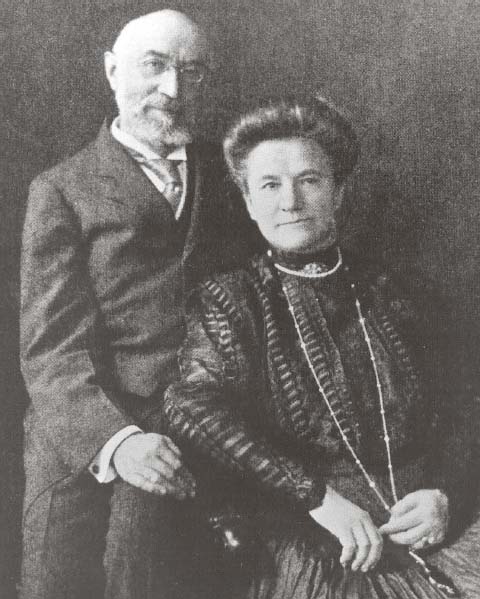
Nearly thirty years later, Pat’s mother Evelyn – known as Evie – sent her and her brother across that same ocean – itself a dangerous journey during wartime; in June 1940 the ship they sailed on, SS Washington, had been stopped by a German submarine on an earlier voyage taking back Americans who had been warned to return to the US without delay or stay in Britain at their own risk. (As a Jew, Evie would have been concerned at what might happen if the Germans invaded. Ten years later, the same ship would sail from Southampton to New York, carrying survivors of the Holocaust.) The liner’s deluxe interior – its staterooms, ballroom and library – was filled with families. Archive film shows the deck piled high with trunks and suitcases, and children being led off the ship on arrival in New York with teddy bears in their hands or in prams and pushchairs. Their evacuation was done for their safety, but Pat came to believe that both her mother and her father wanted to conduct their various affairs unencumbered by their offspring. It had not been a happy marriage. Her parents had divorced in 1936, leaving Evie to conduct an affair with Ralph Murnham (later the queen’s surgeon) before marrying her second husband, Sebastian de Meir, son of a Mexican diplomat, in 1939; he enlisted in the RAF and died when his bomber plane was shot down over the Netherlands in 1942. Evie, who had taken up nursing in London during the war, moved back to New York in 1943.
Pat had always felt abandoned. ‘I was a refugee,’ she says. As a girl, growing up in St John’s Wood in London, she had hidden in the park, imagining herself as an animal; one of the first books she remembers reading, in the nineteen-thirties, was about a boy who was shipwrecked and stranded on an island where he was brought up by wolves. She wanted to be that boy. Her parents did not care about animals; nor did her nanny, whom Pat remembered wearing a sealskin coat. Pat’s mother must have been beautiful and chic. She gave Pat a beaver collar, but Pat refused to wear it, and wouldn’t even touch her mother when she wore her fur coats. Pat remembers when Evie showed her a rug made of cat fur. ‘She knew I loved cats. She hated them.’
A faded photograph in Pat’s bedroom shows ‘Captain E.W.A. Richardson, February 1944’, now serving in the Queen’s Regiment, dressed for the Canadian winter in a white wool duffelcoat as thick as snow. His face is broad and handsome and British. He glows.
Evie’s life was as unstable as the times. In 1945 she married Martin Arostegui, a Cuban publisher whose previous wife, Cathleen Vanderbilt, an alcoholic heiress, had died the year before. Within a year they had separated, and Evie married George Backer, an influential Democrat, writer and publisher of the New York Post. Like his friend Nathan Straus, Backer had worked to save his fellow Jews: in 1933 he had travelled to Poland and Germany to help Jewish refugees flee the growing Nazi menace, and he was awarded the Légion d’Honneur by the French government in 1937 for his efforts. ‘It is horrible to think,’ he would later recall, ‘how responsible we were for all that happened. The ships were there and the people were not saved.’
But Evie’s world was Manhattan, a world of money and powerful people. Her husband’s friends included William Paley, the head of CBS, and Pat recalls that another friend, Averell Harriman, US ambassador to Britain and heir to the largest fortune in America, had also attempted to seduce her mother. Described by the New York Times as ‘a small, fast-moving woman … amusing, gay and sharp-tongued’, Evie drew on her sense of style and her impeccable contacts to become an interior decorator; her clients included Kitty Carlisle Hart, Swifty Lazar and Truman Capote. The pictures in her apartment on the Upper East Side, at 32 East 64th Street, were hung low and small-scale furnishings were chosen to reflect Evie’s five-foot-four stature; she moulded her environment to her requirements, just as her daughter would do. Capote named her ‘Tiny Malice’ for her quick wit. She created a lavish, almost visceral apartment for the writer on the UN Plaza, painting the drawing room blood-red and installing a Victorian carved rosewood sofa, a $500 Tiffany lamp, and a zoo of mimetic and dead animals, from a bronze giraffe and china cats to jaguar-skin pillows and a leopardskin rug. I can hear Pat’s horror. Cecil Beaton called it ‘expensive without looking more than ordinary’. But Capote approved, and asked Evie to design his Black and White Ball, the most famous, or notorious, party of the twentieth century, notable for the fact that, despite Evie’s recommendation, Capote declined to send an invitation to the President.
She and Capote were snapped arriving at Manhattan’s fashionable Colony restaurant. Truman wears a bow tie and horn-rimmed spectacles. He greets the paparazzi, his notorious guest list in his hand; how the magazine editors longed to see that roster. Evie is by his side, thin and chic, conspiratorial in dark glasses. They’re both diminutive, yet the centre of all attention. They retreat to one of the coveted back tables – the Cushing sisters on one side, James Stewart on the other – to plot the party. Margaret, Duchess of Argyll is added to the list – Evie says it never hurts to invite a few duchesses. Later, Capote crosses her off too.
The venue was the Grand Ballroom at the Plaza Hotel, celebrated in the twenties by F. Scott Fitzgerald. The event exceeded any of Gatsby’s parties. Evie ordered red tablecloths and gold candelabra entwined with ‘miles of smilax’, a green vine. The guests wore masks, barely disguising their celebrity: Lauren Bacall and Andy Warhol, Frank Sinatra and Mia Farrow, Norman Mailer and Cecil Beaton, Henry Fonda and Tallulah Bankhead. There were Guinnesses, Kennedys, Rockefellers and Vanderbilts, and it was a marvellous party; its ghosts might still be dancing now.
Evie was never more in her element; her daughter couldn’t have cared less. High society was far from how Pat wanted to live; now she looks at those photographs, those thin society queens, with disdain. She was, and still is, a teenage rebel, a dropout, and had been ever since she first came to Provincetown, at the age of sixteen. In 1946, her mother had rented John Dos Passos’s house in Provincetown’s East End for a year, having been alerted to the Cape’s allure by Dorothy Paley, wife of William Paley and friend of Dos Passos. It was a heady introduction. It changed the course of Pat’s life.
I find it almost impossible – but not quite – to imagine what this place was like then. Its lanes seemed part of the country; many still do. Fishing and whaling had left the remote town open to other influences; a wilderness which allowed the wildness of its inhabitants. Pat worked in the bookshop, but was fired because all she did was read. Then she worked as a waitress in the Flag Ship, where the bar was a boat, and where the owners didn’t feed her. Her mother complained that Pat was losing weight – less attractive to the rich Jewish boys with whom she tried to pair off her daughter. Pat would rather go out on Charlie Mayo’s boat and sit on the fly bridge, watching the whales and birds. Charlie lived across the street. He was a champion fisherman; his family, part Portuguese, had been on the Cape since 1650. His father had hunted whales, as did Charlie; he only stopped when he harpooned a female pilot whale and heard the cries of her calf beneath his boat. Pat saw Charlie as her surrogate father. They talked and fished. Her mother disapproved; she thought Mayo was a communist. Pat didn’t care. She cared about the sea.
Evie had sent her to Austria, in the way that young women of wealthy families were sent to finishing school. Vienna in 1948 wasn’t a good choice for a girl like her; there were no zithers playing, and a former Nazi officer tried to rape her when he discovered she was Jewish. Pat came back to college at Pembroke, outside Boston. She loved riding and skiing. But her mother took her away, and her stepfather arranged for her to go to the University of Pennsylvania in Philadelphia, studying English literature and journalism. Pat felt abandoned all over again.
After graduating in 1953, Pat went to spend time in Benson, Arizona, close to the Mexican border, working on a ranch with the horses she loved. ‘I was outside all the time I wasn’t sleeping.’ She planned to go to Taos, where Georgia O’Keeffe had worked; Pat had an artist friend there, and thought that she might learn to paint. But her mother protested about that, too, and Pat was persuaded to go to Paris, where she worked for the Paris Review and George Plimpton, typing up Samuel Beckett’s manuscripts, riding round the city on a bicycle. She lived in a tiny room at the Hôtel Le Louisiane in Saint-Germain, where Sartre stayed and where the sight of her fellow tenant Lucian Freud, a man who had the look of a raptor, scared her. ‘I was not very hip and was hideously shy.’ On an assignment to Dublin, where her father now lived, Brendan Behan hit on her in a bar.
No wonder. She was a fine, fierce, uncaptured muse, waiting for the moment. In New York she worked for Farrar, Straus & Giroux; Roger Straus was her cousin. She lived in a walk-up at 57 Spring Street, north of Little Italy, which was pretty funky and a long way from the UN Plaza; the building still stands, hung with its fire escape, two doors down from a restaurant called Gatsby’s. The rent was twenty-five dollars a month. Pat would fight with Italians for parking space for her black business coupé, and thought the poor Puerto Rican families were happier than her. On Friday nights she’d leave the office and drive all the way to Mount Washington to ski.
When she had to leave her apartment she moved to the Chelsea Hotel, setting up an office in her room. She took a course in book design at New York University with the designer Marshall Lee. ‘He was a good teacher.’ It was the only formal training she had. She excelled at it. Even now she’ll hand me a new book from her packed shelves and flick through it, expertly analysing its qualities. Her designs were simple and smart. For Thom Gunn’s collected verse she created a helical motif, a graphic contrast to the poet’s photograph on the back, showing the bearded Gunn crouching in a field, shirtless, in tight jeans, a leather belt loaded like his name. Bennett Cerf, the celebrated founder of Random House, told her mother how brilliant Pat’s designs were. Evie just asked her daughter, ‘Exactly what is it that you do?’
Pat and Evie. The pearls. The champagne. The lighted cigarette.
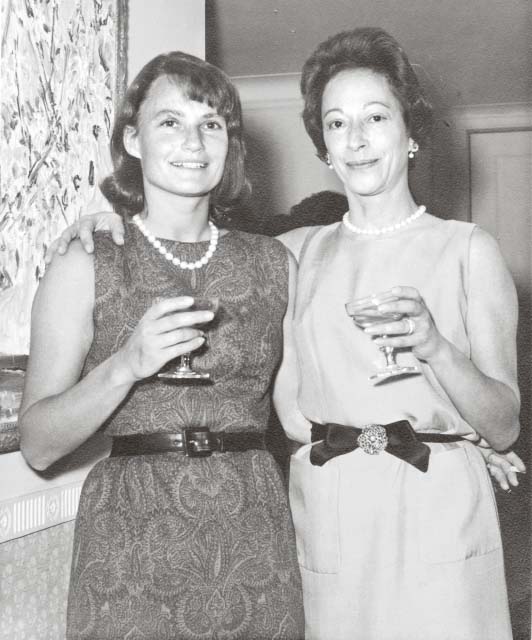
Manhattan could never rival Provincetown, and Pat kept coming back. In the summer of 1956 she met Nanno de Groot, a Dutch-born artist, for the second time, having met him briefly when she was eighteen and he was living with his third wife, Elise Asher, in the West End, next to friends of Pat’s. That second meeting was memorable: ‘When I woke up he was sitting on top of a weir pole, on his feet like a bird looking out to sea, waiting for me.’
He was an imposing figure, forty-three, six foot four, often bare-chested, and always bare-footed, as Pat would be. He’d been to nautical school in Amsterdam and had served on submarines, but was now the artist he had always wanted to be, part of the New York circle of de Kooning, Pollock, Franz Kline and Rothko. ‘We spent that week together,’ says Pat. She moved into his farmhouse in Little York, New Jersey. They got married on Long Island two years later; the reception was held at the Backers’ summer house on the sea-surrounded Sands Point – Daisy Buchanan’s East Egg. In the winter they lived in Little York; Nanno painted, Pat went to work in the city. In the summer, they’d return to Provincetown, living in a three-room cabin in a field at the end of town. A photograph shows them there: white light, Nanno naked to the waist, Pat svelte and tanned too, feet up on a table. Nanno painted the trees and the land and the sea – the passing seasons, fishermen’s nets drying in the fields – in between working as a mate on Charlie’s boat.
It must have been mad and idyllic and frustrating and ecstatic, this life together, in the dunes, on the streets, at sea. Pat remembers 1961, the summer with no wind, when they’d go out on the boat in the glassy calm, so clear you might reach down and pluck fish out of the depths. It was ‘a visual onslaught’, Pat says in a later, filmed interview in which her style emerges, a mix of bohemian smartness and concentrated beauty. With her wavy, centre-parted hair she might be one of the Velvet Underground, or a Renaissance model. She looks straight at the camera, but sees something else in the distance. She talks about Nanno, who wrote, ‘In moments of clarity I can sustain the idea that everything on earth is nature, including that which springs forth from a man’s mind, and hand.’ He read Robert Graves’s The White Goddess and painted birds; birds which, as Pat says, ‘he felt he might have become’, just as she might have become a wolf.
From one of her studio shelves, low down where the cats prowl, Pat pulls a brown envelope, and from it a photograph of herself and Charlie.
It’s 1961. There’s no wind. The five-hundred-pound tuna dangles between them, suspended by a rope around its tail, so huge and bug-eyed, so stuck over and spiny it’s hard to believe it’s not cut out and glued on. They each hold a fin, these two anglers, smiling for the camera, proud of their catch.
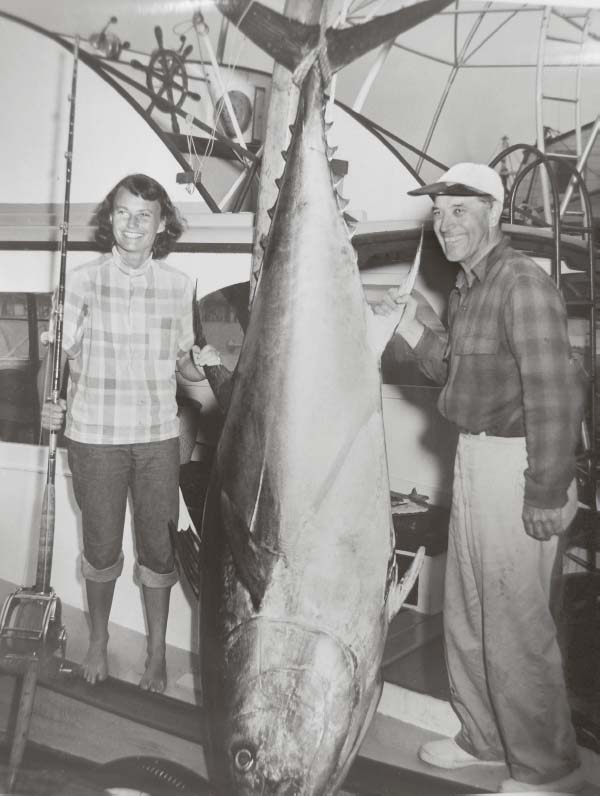
Pat has a huge rod and reel. As slight and chic as she seems, in her rolled-up jeans, checked shirt and suntan, it was Pat, not Charlie, who did all the work; Pat who struggled to hoick the bluefin out of the sea and onto the deck; Pat who was given the trophy by the state governor for her prize catch, seen in another press photograph, dressed in a dark silk shirt-waister, as shiny as a fish, her glossy hair in curls. She looks like Hepburn or Bacall, gamine and self-assured, with Charlie as her Bogart.
It was Nanno and Charlie and Pat, out fishing, part of the sea. In 1962, Nanno and Pat built this big house, created to enable thin slivers of art. They bought the land for six thousand dollars. Pat drew up the plans and the house grew up from the shore. It didn’t so much look out to the sea as the sea looked into it.
‘It wasn’t conceptual,’ Pat says. ‘It rose up out of the mud.’ Locals thought it was impractical. It seemed built out of belief alone. A factory of the imagination.
That same year came Nanno’s diagnosis, ‘and everything that goes with that’. Photographs show him bundled up to the neck, sitting on the deck, while the house rises pristine behind him, full of light and space. Living with lung cancer, he painted his last painting, of the sea, the large canvas laid flat, supported on stools. It showed the harbour flats drained at low tide. For the first time, he painted no horizon.
‘It was,’ said Pat, ‘his last word on the subject of painting.’ They moved into the house at Thanksgiving, 1962. They were there together barely a year. The following Thanksgiving – just days after President Kennedy was shot – there was a terrible storm which worked its havoc through three high tides. ‘It took the bulkhead, the deck, and almost undermined the house,’ Pat recalls. A month later, that Christmas, Nanno died.
Pat had his coffin constructed from red cedar left over from the building of their house; as if he were being launched out to sea, like Ishmael. Nanno’s tempestuous scenes of the Atlantic shores still hang on these walls: Ballston Beach bursts with energy, as if it were just a window on the wall looking over to the ocean side of the Cape. Every cupboard, every drawer, every eave of this house is filled with art. Art seeps out through the knots in the wood, like the sea under the floorboards.
There were parties here back in the sixties and seventies, recorded in flaring home movies and remembered in the stories of those who attended them and spent a night in gaol for disturbing the peace. There were psychedelic drugs, and when Pat invited jazz musicians, like her lover, Elvin Jones, she’d find rotting fish on her doorstep, left by folk who took offence at her having brought black people to town. Nina Simone visited; I imagine coming downstairs and finding her sipping tea at Pat’s long table, talking in her rich voice. A faded photograph pinned to the wall shows Pat and her friends playing congas out on the deck. The drums still stand in her living room, but they haven’t been played in a while.
Pat had other visitors to attend to. In 1982, a lone orca appeared in the bay. It was a female, apparently habituated to humans; some thought it was an escapee from a military marine mammal programme, a dolphin draft-dodger. It was the biggest animal she would meet. Pat would kayak out to meet it and drew it over and again, this time using her black marker on flat stones. With the fin rising next to her boat, Pat held out a flounder to her friend.
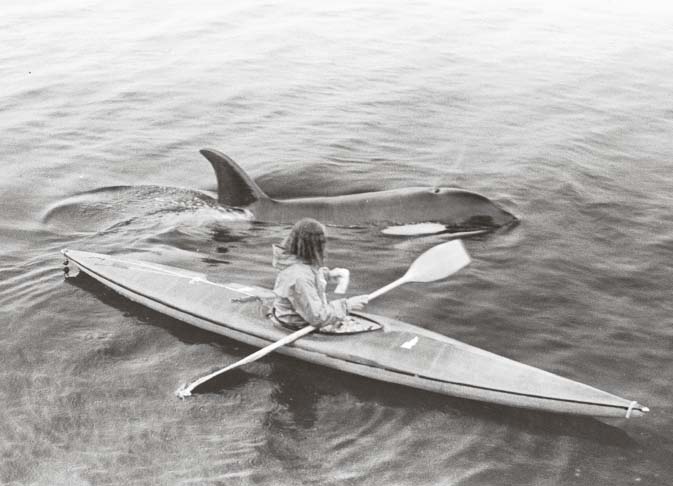
Others were less considerate when the whale came in close to the pier. ‘Someone poured bourbon in her blowhole,’ Pat says. After that, the harbourmaster drove the whale back out to sea.
This house is rebuilt with every season, growing layer upon layer. Giant jade and ficus plants tower in the interior, tended by rainwater collected from the roof. Buddha sits in his lotus position in the garden. The outside comes inside. In the yard, self-seeded trees shade the graves of departed dogs; great strings of blue lights illuminate their branches as night falls. Robins and cardinals take refuge up there from the cats to whom this house really belongs, familiars to their mistress.
It is the very antithesis of the order her mother created in fashionable Manhattan. Books and catalogues rise in piles on every step of the stairs. Dusty drawers are filled with cormorants cawing and clamouring to get out. If Pat no longer paints, perhaps it is because she has said what she needed to say. Now she collects stones from the shore as she walks it in her light leaping stride, pocketing pieces of seaworn granite and quartz to be arranged on her tables outside with no purpose but every intention. Years ago, in 1954, when she was typing out Beckett’s Molloy for the Paris Review, she became fascinated with the ‘sucking stones’ section.
‘I spent some time at the seaside, without incident,’ says Molloy. ‘Personally I feel no worse there than anywhere else … And to feel that there was one direction at least in which I could go no further, without first getting wet, then drowned, was a blessing.’
He then performs a strange, obsessive rite.
‘I took advantage of being at the seaside to lay in a store of sucking-stones. They were pebbles but I call them stones. Yes, on this occasion I laid in a considerable store. I distributed them equally between my four pockets, and sucked them turn and turn about.’
‘For ten pages, in one paragraph,’ says Pat, ‘he moves these stones in and out of his pockets and his mouth, working on a complicated logistic with the order of sucking each stone and where to put it after it is sucked so it won’t get sucked again before all sixteen stones have, in turn, been sucked and put in the proper pocket. It took me a long time because I constantly got lost. I read and read this piece. Those stones stay with me …’




